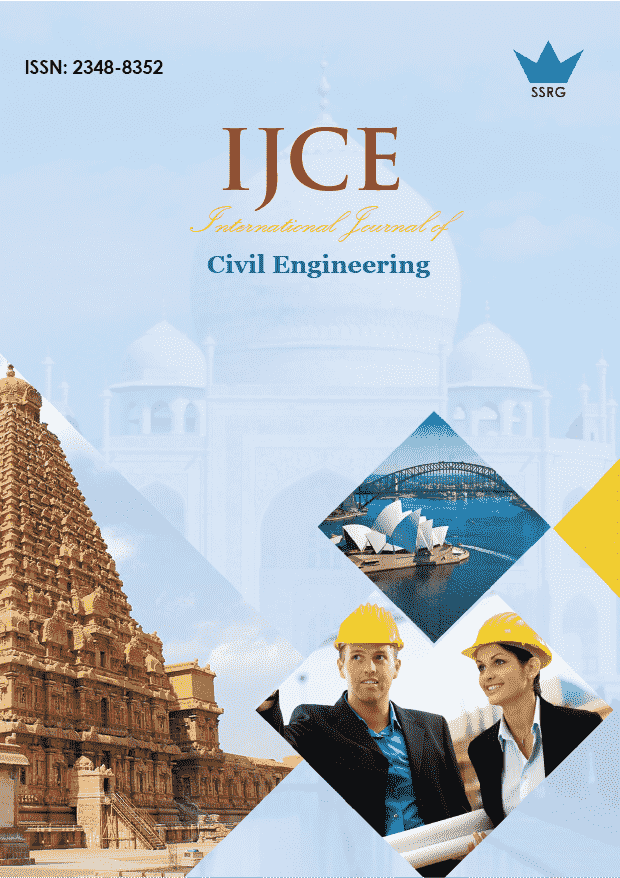Effect of Marble Powder and PVA Fibres on the Strength and Microstructure of Engineered Cementitious Composite by using Non-Destructive Test

| International Journal of Civil Engineering |
| © 2019 by SSRG - IJCE Journal |
| Volume 6 Issue 3 |
| Year of Publication : 2019 |
| Authors : Pradnya M. Patil, Raju Narwade, Karthik Nagarajan |
How to Cite?
Pradnya M. Patil, Raju Narwade, Karthik Nagarajan, "Effect of Marble Powder and PVA Fibres on the Strength and Microstructure of Engineered Cementitious Composite by using Non-Destructive Test," SSRG International Journal of Civil Engineering, vol. 6, no. 3, pp. 50-56, 2019. Crossref, https://doi.org/10.14445/23488352/IJCE-V6I3P108
Abstract:
Generally, it is a known fact that concrete is the main material used in engineering projects for all the important works. This material has high compressive strength, but it is weak in tension. A smart material, namely Engineered Cementitious Composite, commonly known as bendable concrete, was introduced to rectify this problem.
This research emphasizes the influence of marble powder as a binder in engineered cementitious composites. Composites containing different marble powder levels with partial replacement of ordinary Portland cement by 5%, 10%, 15%, and 20% are examined. To determine the effect of PVA fibers in ECC and to find the compressive strength, the matrix was produced and tested using a non-destructive test such as the Ultrasonic pulse velocity test. The microstructure analysis and the matrix's chemical composition were determined by scanning electron microscopy and X-ray diffraction test. The result showed that the velocity obtained for the concrete cubes comes in the range of 3.5 to 4.5 km/Sec. This indicates that the quality of concrete is good and can be used for construction purposes. An effort has been taken to analyze chemical compounds' micro level formation by scanning electron microscope (SEM) and X-ray diffraction (XRD).
Keywords:
Engineered Cementitious Composites, Marble Powder, Ordinary Portland Cement, Ultrasonic pulse velocity, Scanning Electron Microscope, X-ray Diffraction.
References:
[1] Victor C Li., Engineered cementitious composites (ECC)” – Material, Structural and Durability Performance, University of Michigan, Ann Arbor., (2007),2-26.
[2] SevgiKilic, et al.,Stability of CaCO3 in Ca(OH)2 solution, International Journal of Mineral Processing., 147,1–9, (2016).
[3] Yu Zhu, et al.,Effect of Water-Curing Time on the Mechanical Properties of Engineered Cementitious Composites,Journal of Material in Civil Engineering (ASCE), 28(11), (2016),0899-1561 .
[4] YogeshAggarwal and RafatSiddique.,Microstructure and properties of concrete using bottom ash and waste foundry sand as partial replacement of fine aggregates, Construction and Building Materials.54, (2014),210-223.
[5] A. Khitab, et al,.Use of Flexible Engineered Cementitious Composite in Buildings, Key Engineering Materials.,510-511 , (2012),591-596.
[6] En-Hua Yang and Victor C. Li.,Tailoring engineered cementitious composites for impact resistance, Cement and Concrete Research.,(2012),42,1066–1071
[7] Mohamed Maalej, et al.,Behavior of Hybrid-Fiber Engineered Cementitious Composites Subjected to Dynamic Tensile Loading and Projectile Impact, Journal of Materials in Civil Engineering © ASCE,17 (2), (2005),143.
[8] Mustafa Şahmaran, et al.,Effect of Fly Ash and PVA Fiber on Microstructural Damage and Residual Properties of Engineered Cementitious Composites Exposed to High Temperatures” Journal of Materials in Civil Engineering (ASCE), 23(12), (2011),1735-1745.
[9] Nagaraju P., et al.,An Experimental Study on Partial Replacement of Cement with Marble Powder, International Journal of Research Sciences and Advanced Engineering [IJRSAE]., 2(15), (2016),99 – 111.
[10] Selvakumar, Kishore Kumar, Deivasigamani and Amutha, ,Experimental study on bendable concrete, SSRG International journal of civil engineering, special issue., (2017).
[11] Yingzi Yang et al., Autogenous healing of engineered cementitious composites under wet-dry cycles,Cement and Concrete Research, 39,(2009),382–390
[12] Jun Zhanget al.,Engineered cementitious composite with the characteristic of low drying shrinkage, Cement and Concrete Research.,39, (2009) ,303-312
[13] Victor C. Li et al.,Micromechanics based durability study of polyvinyl alcohol engineered cementitious composite” ACI Materials Journal.,101(3),(2004),242-248.
[14] Victor C Li.,Engineered cementitious composites (ECC), – Material, Structural and Durability Performance, University of Michigan, Ann Arbor. (2007),2-26.
[15] Xia Hua, Self‐healing of Engineered Cementitious Composites (ECC) in Concrete Repair System, MSc., thesis, Delft University of Technology., (2010).

 10.14445/23488352/IJCE-V6I3P108
10.14445/23488352/IJCE-V6I3P108